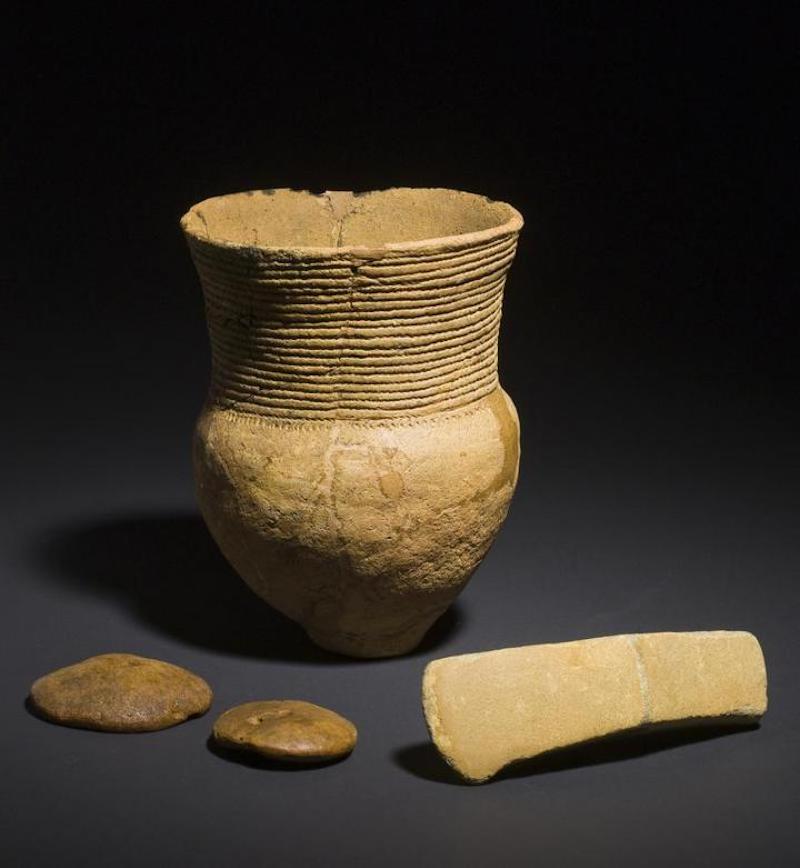Culture Change: War Bands Hooked Up With Neolithic Farm Women

Nearly 5,000 years ago, a new type of pottery arose across Europe. Imprinted with elaborate cord-like designs, the pottery came to mark a mysterious culture known, appropriately enough, as the Corded Ware culture.
Now, researchers find that the appearance of these new designs may have been the result of intermarriage between Neolithic farm women of Europe and incoming warriors from the Pontic and Caspian steppes near the Black and Caspian seas. The evidence for this cultural melding comes from linguistics studies, from ancient DNA evidence and from molecular clues about the diets of these ancient peoples.
"A new material culture emerged in the meeting between the groups," said Kristian Kristiansen, an archaeologist at the University of Gothenburg, in Sweden, who co-authored a new study published online April 4 in the journal Antiquity that synthesized this disparate evidence. "The point we make is that it was the women who were the agents of change." [7 Bizarre Ancient Cultures That History Forgot]
Cultural melting pot
The story emerging about the formation of the Corded Ware culture starts on the steppe, where people from a culture called the Yamnaya herded cattle and other livestock, living a nomadic life out of wagons. Right around 3000 B.C., genes matching those found in the Yamnaya people suddenly started showing up in Europe. At the same time, genes found in people belonging to earlier Neolithic farming societies in Europe became markedly less common.
There was an outbreak of plague just prior to 3000 B.C. that wiped out Neolithic farmers from Siberia to the Baltic, Kristiansen said, which may have opened up new territory for the Yamnaya people to migrate off the steppe and into eastern Europe.
Archaeological finds from the Corded Ware culture suggest that it was these Yamnaya immigrants who mixed with Neolithic farmers to form the new culture. More specifically, Yamnaya men seemed to have mixed with European Neolithic women, researchers have found. In the earliest Corded Ware burials from Jutland (the peninsula that makes up modern-day Denmark and part of Germany), 90 percent of the bodies are male, Kristiansen said.
Ancient tragedy
There are other clues, as well — and some are tragic. At a site called Eulau in Germany, archaeologists discovered 12 graves dating back 4,600 years, each holding the bodies of several men, women and children. The skeletons showed signs of horrible trauma: cracked skulls, arrow marks and broken wrists. The dead appeared to have been killed in a violent attack or raid.
Get the world’s most fascinating discoveries delivered straight to your inbox.
Using isotope tests that look for molecular variations in teeth that are due to an individual's diet, researchers have found that between 28 percent and 42 percent of the women in the graves spent their childhoods following a grain-rich agricultural diet — "bread and muesli," Kristiansen said.
"That was not the diet of the Corded Ware people," he said. "They were into yogurt and meat and cheese and things like that."
This dietary evidence suggests that Corded Ware men married women from established agricultural areas in Europe, perhaps by force. An earlier kidnapping of women might explain why that particular group was attacked, Kristiansen and his colleagues wrote. They were killed by people wielding European neolithic weapons, so the raid may have been an act of revenge. [25 Grisly Archaeological Discoveries]
Melding cultures
However the marriages were made, they altered the culture of Europe, according to the researchers. Neolithic women, familiar with making ceramics, probably developed corded ware pottery in order to evoke the woven and wooden containers that would have been familiar to the Yamnaya husbands. They would have also brought with them knowledge of agriculture, Kristiansen said.
In fact, language was another place where the Neolithic women probably made their mark. While crop- and farm-related words in early Indo-European languages have been difficult to reconstruct, linguistically, researchers have been able to trace the roots for dairy- and wool-related words back to early Indo-European speakers. It appears, Kristiansen said, that the Yamnaya — Proto-Indo-European speakers who eventually developed Proto-German, from which all Germanic languages would spring — picked up their words for farming from the neolithic European cultures that they encountered as they moved west.
The next steps, Kristiansen said, are to figure out what happened after the Corded Ware culture established itself. Kristiansen is now looking into the genetic history of Mediterranean peoples; he's also working in collaboration with several genetics research groups to find out more about the Bell Beaker culture, which was a contemporary of the Corded Ware people from Western Europe.
"In two or three months, you will get the answer to that one," Kristiansen said.
Original article on Live Science.

Stephanie Pappas is a contributing writer for Live Science, covering topics ranging from geoscience to archaeology to the human brain and behavior. She was previously a senior writer for Live Science but is now a freelancer based in Denver, Colorado, and regularly contributes to Scientific American and The Monitor, the monthly magazine of the American Psychological Association. Stephanie received a bachelor's degree in psychology from the University of South Carolina and a graduate certificate in science communication from the University of California, Santa Cruz.


